Honeysuckle thrives on garden fences when given proper support and care. For best results, install sturdy fences at least 5-6 feet tall, plant vines about a foot away from the structure, and train them using ties or trellises. Make sure adequate sunlight, regular watering during dry periods, and periodic pruning to prevent tangling. Companion planting with bee balm or lavender enhances pollination and pest resistance. These simple strategies will transform your fence into a stunning, fragrant vertical garden.
Choosing the Right Fence Structure for Honeysuckle Success
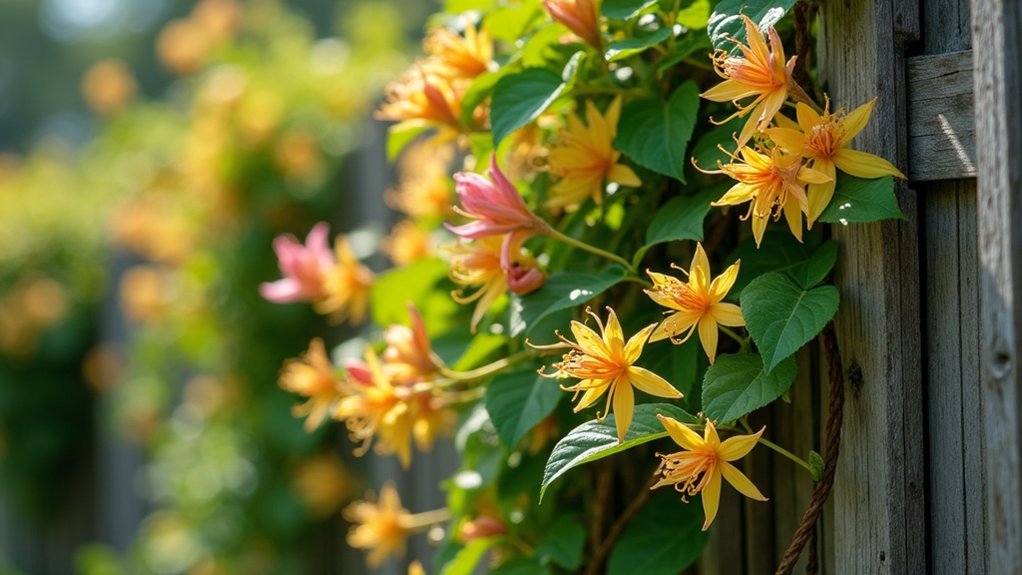
When planning to grow honeysuckle on your garden fence, selecting the appropriate structure serves as the foundation for success. Your fence should stand at least 5-6 feet tall to accommodate the climbing nature of these vigorous vines while providing enough space for them to create a dense, lush covering.
A sturdy fence of at least 5-6 feet provides the essential foundation for honeysuckle to climb and flourish into a magnificent garden feature.
Choose materials that can bear the weight of mature honeysuckle—wood or metal options offer excellent durability. Install sturdy trellises or lattice supports that allow vines to climb and spread naturally.
Remember to position your fence structure about one foot away from the planting site to guarantee adequate air circulation and prevent overcrowding.
The orientation of your fence matters greatly too. Position it for maximum full sun exposure, as this encourages ideal flowering and maintains the overall health of your honeysuckle display.
Optimal Spacing and Planting Techniques for Fence Coverage
Although honeysuckle vines grow vigorously, proper spacing and planting techniques remain essential for achieving full fence coverage without overcrowding.
Position your honeysuckle plants approximately one foot away from the fence to guarantee adequate air circulation around the roots and stems.
When planting, dig holes deep enough to accommodate the entire root ball and enrich the soil with compost.
Spring or fall planting, after the final frost has passed, gives your honeysuckle vines the best chance to establish strong root systems before active growth begins.
Regularly train and secure the vines to your fence as they grow.
Consider planting multiple climber varieties for quicker coverage and visual interest.
This strategy also provides assurance against potential plant failure, guaranteeing your fence remains beautifully adorned.
Training Young Honeysuckle Vines on Fence Supports
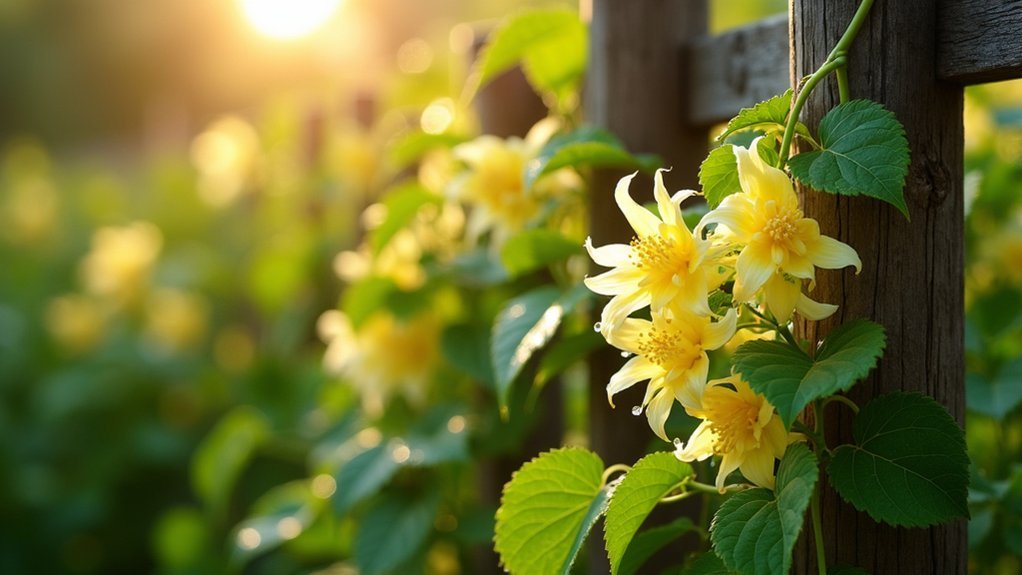
Successful honeysuckle growth depends on proper training during the plant’s formative stages.
Begin by positioning your vines about 1 foot from the fence to guarantee adequate airflow and root development. As your honeysuckle grows, install sturdy string supports or trellises to guide the climbing pattern.
Give your honeysuckle breathing room and proper support for healthy growth and ideal climbing behavior.
Secure the stems with ties regularly, directing the main growth along one side of the fence while allowing side shoots to fan out evenly for balanced coverage. This organized approach prevents tangling and makes future maintenance simpler.
Don’t neglect pruning—it’s essential for maintaining the desired shape and preventing overcrowding on your supports.
Creating Effective Trellis Systems Within Fence Designs
Designing an integrated trellis system for your fence transforms it from a simple boundary into a living canvas for honeysuckle displays.
Position your trellis at least 10-11 inches away from the planting hole to guarantee your flowering vines receive adequate airflow and space to develop robust root systems.
Choose sturdy materials that can support honeysuckle’s vigorous growth habit. You’ll achieve balanced growth by arranging vines horizontally or at 45° angles across your trellis systems, making maintenance considerably easier.
As stems develop, secure them to the support structure regularly.
For visual interest, consider combining honeysuckle with complementary climbing plants like clematis or roses on the same framework. This pairing creates stunning seasonal displays while maximizing your fence’s vertical garden potential.
The right trellis design will showcase honeysuckle’s beauty while maintaining its health.
Seasonal Maintenance for Fence-Growing Honeysuckle
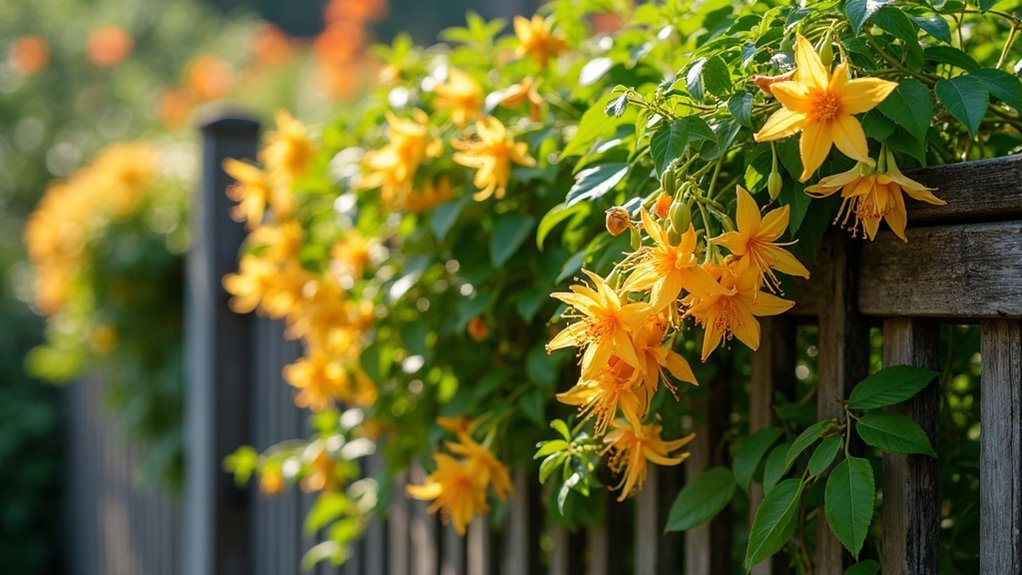
Proper pruning forms the backbone of honeysuckle maintenance, requiring you to trim back tangled stems in late winter to encourage robust spring growth while removing damaged sections throughout growing seasons.
You’ll need to protect your fence-growing honeysuckle during harsh winter months by applying a thick layer of mulch around the base and potentially wrapping young plants in burlap when temperatures drop considerably.
Winter protection measures work best when combined with reduced watering during dormancy, allowing your honeysuckle to rest before spring’s revival.
Pruning Through Seasons
While fence-growing honeysuckle offers magnificent blooms and fragrance, it requires thoughtful seasonal maintenance to thrive without overwhelming your garden structure.
Time your primary pruning for late winter or early spring before new growth emerges to encourage healthy blooms. Remove tangled stems and overcrowded growth to improve air circulation and light penetration. You’ll find that regular attention prevents your honeysuckle from becoming a dense, unmanageable mass on your fence.
Don’t overlook the importance of removing dead wood during each pruning session—this simple step prevents pest problems and improves overall plant health.
For vigorous varieties like Lonicera japonica, more frequent trimming is necessary. Consider light pruning after flowering ends to potentially trigger a second bloom cycle, particularly with re-blooming varieties.
Winter Protection Techniques
Most honeysuckle varieties display impressive resilience, but they’ll still benefit from thoughtful protection during harsh winter months. Apply a generous layer of mulch around the base to insulate roots while maintaining moisture—crucial even for these drought-resistant climbers.
Before spring growth emerges, prune any dead or damaged stems to encourage healthy blooming and prevent disease. For gardens in zones 4-5, consider wrapping your trellis with burlap or frost cloth to shield plants from biting winds and freezing temperatures.
Ensure well-drained soil throughout winter by amending with compost in fall, which provides nutrients during dormancy.
Don’t forget to regularly inspect for pests that can damage even dormant vines. Apply natural pesticides when necessary to keep your fence-climbing honeysuckle healthy until spring returns.
Managing Rapid Growth Patterns Along Fence Lines
You’ll need to monitor your honeysuckle’s aggressive growth pattern to prevent it from overwhelming your garden fence.
Train the main stems along your support structure by gently attaching them with garden ties, directing them to grow where you want coverage.
Keep the vine about 12 inches away from the fence to guarantee proper air circulation and make maintenance easier as the plant matures.
Growth Pattern Control
Since honeysuckle vines grow with remarkable vigor, establishing proper growth patterns early is crucial for maintaining an attractive fence display.
You’ll need to implement regular pruning to manage their ambitious growth, which can quickly reach 5-20 feet in height.
Begin by training stems to twine around your fence or trellis during early development. Position plants about a foot from the support structure to guarantee proper air circulation and disease prevention.
As your honeysuckle matures, fan out side shoots evenly to encourage balanced growth and maximize flowering potential.
Don’t neglect maintenance—monitor your vines consistently and prune during late winter or early spring to shape the plant effectively.
This systematic growth pattern control prevents your honeysuckle from overwhelming the fence while still providing the lush, flowering coverage you desire.
Training Alongside Supports
While growth pattern control forms the foundation of beautiful honeysuckle displays, proper training techniques will determine how elegantly your vines integrate with their support structure.
Install sturdy trellises or fences to accommodate honeysuckle’s vigorous climbing nature, allowing the vines to twine naturally around these supports.
When planting, position your honeysuckle about 10-11 inches from the fence to provide adequate root space.
Direct new growth consistently to one side, securing stems with garden twine to guide their development along your chosen path. This strategic training prevents tangling while creating an organized appearance.
Schedule pruning sessions for late winter or early spring to maintain shape and encourage healthy flowering.
Enhancing Flowering Performance on Vertical Structures
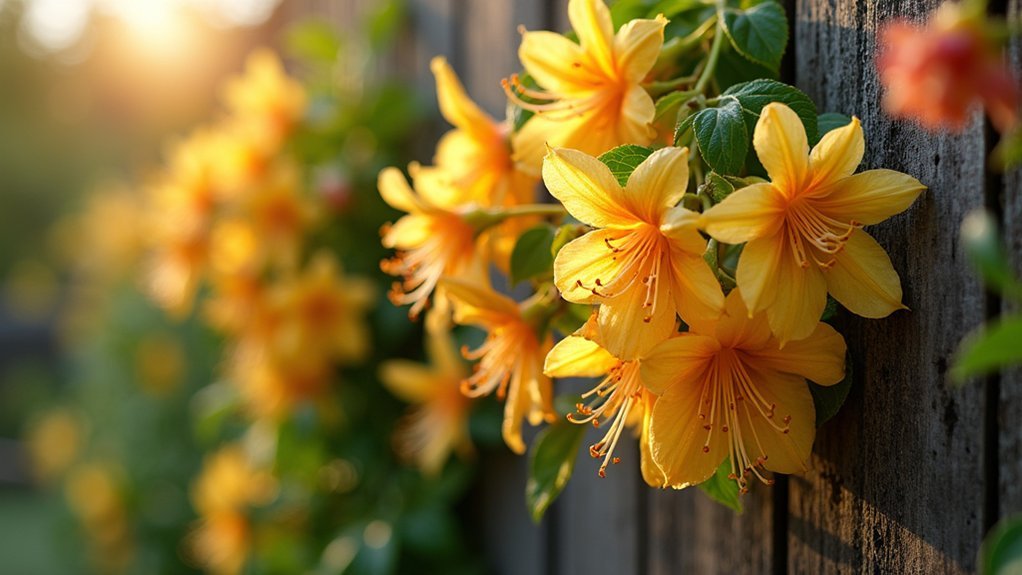
When honeysuckle climbs vertically on garden fences, it achieves its most spectacular flowering display. Your honeysuckle vine will produce maximum blooms when you position it in full sun to partial shade along your fence line. This vertical orientation helps the plant receive consistent light exposure throughout the day, which triggers prolific flowering from spring through autumn.
Ensure well-draining soil enriched with compost to enhance flowering potential. Regular pruning is essential—remove tangled growth and spent flowers to stimulate new blooms and improve air circulation.
For best results, install your trellis or support structure 10-11 inches from the planting hole, allowing the roots to establish while the vines reach upward. This strategic spacing gives your honeysuckle room to develop its characteristic cascading flower clusters that will transform your garden fence into a fragrant, colorful backdrop.
Addressing Common Challenges of Fence-Trained Honeysuckle
Despite their resilient nature, honeysuckle vines trained on garden fences face several common challenges that can hinder their growth and flowering potential.
When creating your planting hole, position the vine at least one foot from the fence to guarantee proper air circulation and reduce disease risk.
Remember to water your honeysuckle thoroughly during dry periods, especially when newly established. Regular pruning is essential not only for maintaining an attractive shape but also for preventing the dense growth that can lead to powdery mildew.
Be vigilant for cutter ants that can damage foliage and blooms.
While honeysuckle provides beautiful coverage for fences, some varieties are invasive in some regions, so choose species appropriate for your area to avoid unwanted spreading into neighboring gardens.
Companion Plants for Fence-Growing Honeysuckle Arrangements
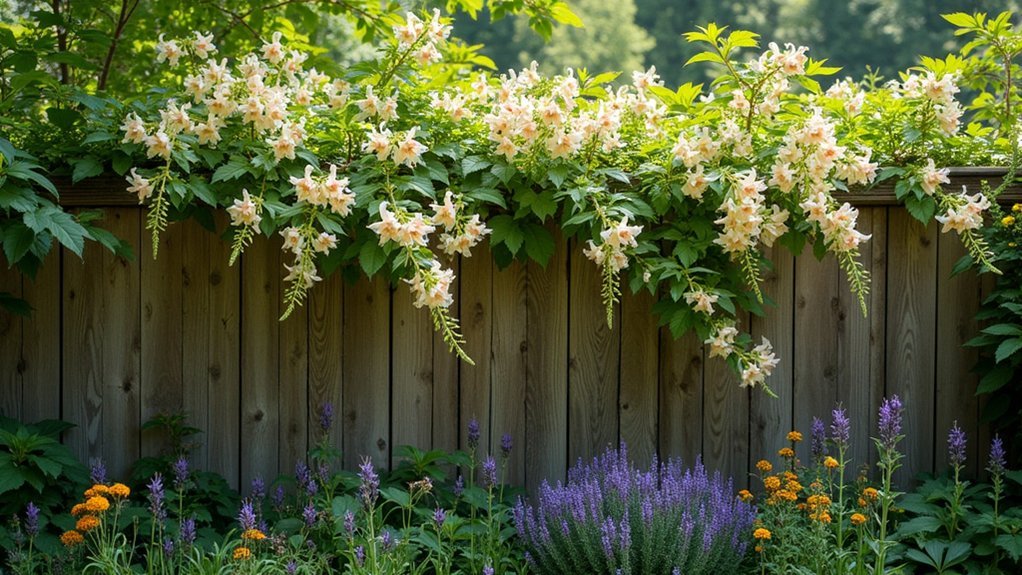
To maximize the visual impact of your fence-trained honeysuckle, carefully selected companion plants can create a stunning garden tapestry.
Clematis and climbing roses offer contrasting colors and textures that enhance honeysuckle plants without competing for space.
Attract pollinators by planting bee balm nearby—this creates a biodiverse ecosystem that improves honeysuckle’s flowering potential.
Fragrant herbs like lavender not only complement honeysuckle’s sweet scent but also naturally repel potential pests.
For visual drama, pair honeysuckle with golden creeping jenny, whose variegated foliage highlights the vibrant blooms.
Fast-growing annuals such as nasturtiums provide practical benefits too, suppressing weeds and providing ground cover while your honeysuckle establishes itself.
These thoughtful combinations guarantee your fence display remains both beautiful and ecologically balanced.
Long-Term Care Strategies for Established Fence Honeysuckle
Once your fence display is thriving with honeysuckle and its companions, your attention should shift to maintaining this botanical investment for years to come. Implementing proper long-term care strategies guarantees continuous beauty and health.
| Season | Essential Care Task |
|---|---|
| Late Winter | Prune established honeysuckle to remove tangled stems |
| Early Spring | Apply general-purpose fertilizer for vigorous growth |
| Summer | Water during dry periods despite drought tolerance |
| Growing Season | Monitor and treat for aphids and mites with insecticidal soap |
| Year-round | Train the vines regularly on your fence or trellis |
You’ll need to prune in late winter to encourage healthy growth and abundant flowering. Though mature plants tolerate drought, they’ll still benefit from consistent hydration during extended dry spells. Remember to direct growth by training vines evenly across your fence to prevent tangling and guarantee spectacular blooming.
Frequently Asked Questions
How to Make Honeysuckle Thrive?
To make honeysuckle thrive, you’ll need sturdy supports, well-drained soil with compost, full sun exposure, regular pruning after flowering, and thorough watering during dry periods. These conditions encourage robust growth and abundant blooms.
Why Is My Honeysuckle Not Thriving?
Your honeysuckle may not be thriving due to poor drainage, insufficient sunlight, overcrowding, inadequate watering, or pest issues. Check your soil conditions, guarantee it gets enough sun, and monitor for insect damage.
What Is the Best Fertilizer for Honeysuckle?
For honeysuckle, you’ll want a balanced 10-10-10 slow-release fertilizer. Apply it in early spring when growth begins. Don’t overdo it—excessive fertilizing causes leafy growth but fewer blooms. Organic options like compost work well too.
What Is Attracted to Honeysuckle?
Your honeysuckle will attract hummingbirds, bees, and butterflies seeking its sweet nectar. You’ll also notice ladybugs visiting the fragrant blooms, while songbirds and finches come for the berries as food sources.
In Summary
You’ll find that honeysuckle thrives on garden fences when you provide proper support structures, consistent maintenance, and ideal growing conditions. By selecting appropriate trellising, spacing plants correctly, and implementing seasonal care routines, you’re setting the stage for robust growth. Don’t forget to address challenges promptly and consider compatible companion plantings. With these strategies, you’ll enjoy a flourishing honeysuckle display that transforms your fence into a fragrant, flowering showcase.

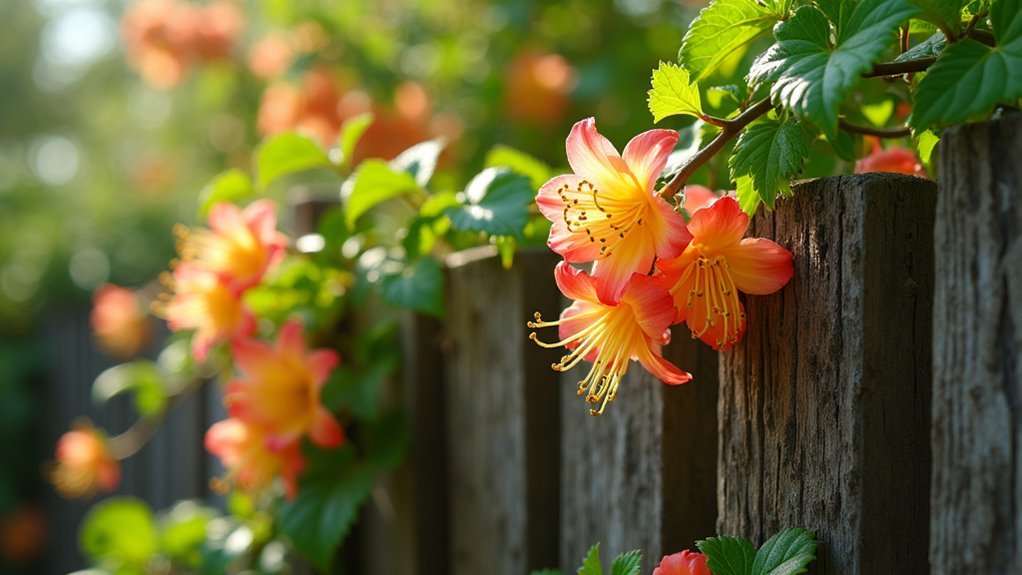



Leave a Reply